Thus, the method and the madness behind Black Diamond’s JetForce technology begins to look like a nice mix of convenience and cost, bordering on genius. Okay, genius might be overstating it, but from the standpoint of taking a concept to the next level, JetForce may render the cartridge style airbag packs evolutionary Dodos. Make no doubt about it, that is Black Diamonds economic intent, and Arcteryx hopes so too. The practical and economic issues do suggest a battle for the survival of the fittest, and lest you think that is all there is to this pack, consider the effect of software on the equation.
Multiple Inflations
Consider that you can get multiple inflations with a single charge. Charge, in this case is not filling up a cartridge, but storing up energy in a Lithium-ion battery to spin the blades of a fan that fill the airbag. The air is sucked in through a meshed port in the lower left corner of the pack, and through the breathable mesh back panel and the mesh holding the airbag around the perimeter of the pack.Cost
Economically speaking the pack isn’t exactly cheap, but practice sessions won’t cost you a few Jackson’s and logistical time. Charging up the battery might nickle and dime you, and the replacement battery won’t be exactly cheap, but you ought to get a couple years worth out of one battery and who knows how many deployments that could be. Realistically you won’t fire the thing off more than a half dozen times a year, but even that is several hundred more percent that you would practice if it cost you $40 bucks each time, or even just $20.
Flying Restrictions
As far as the flying with the JetForce, the lithium-ion battery could pose a problem, but not an insurmountable one. Rechargeable lithium-ion batteries have a history of bursting into flames. Thus, you probably won’t be able to load it in the cargo hold, but you could carry it on where a fire extinguisher is available and the battery accessible should it need to get doused. Unlikely, but you never know what sort of people those backcountry skiers are, especially those smellymarkers.Oversized Airbag
There are other reasons the JetForce system may be superior to cartridges. For starters, it has a 200 liter airbag. That’s 17% larger than ABS and Mammut’s Protective Airbag System, and 25% larger than everyone else. The reason airbags work in an avalanche means bigger is better.
Software?
My fave feature of the airbag is the ability to sense the pressure in the airbag and attempt to maintain it, even if the bag gets punctured. The ability to do that is dependent on something I’m admittedly ambivalent about – software. The JetForce doesn’t just turn on a fan and fill the bag, then turn off. That would be too simple. No, it has pressure sensors somewhere to detect the pressure in the airbag and attempt to maintain that pressure by pulsing on for a few minutes to maintain pressure. If it notices it cannot hold pressure, the fan remains on and can keep it inflated to 150 liters with a 5-inch (12 cm) gash.My reluctance has to do with the tendency for microprocessor controlled stuff to simply not cooperate. In BD and co-developer Pieps’ defense, they’ve been in the software game long enough through their headlamp division and Pieps beacons, and the sort of routine that they are performing is not that complex. Which brings us to the good part of the software. Since it is software, it can be upgraded, which so far in the avalanche safety world, does tend to mean steady improvements.
For example, in the beta version I tested back in December (see in the video above), the trigger didn’t react the way I expected it to. I pulled hard on the trigger and held it there and it didn’t do anything — until I let go. The software expected a pull followed by a release. That sort of snafu can be fixed with an upgrade, and I’m told, already has been.
Lest I forget, that software causes the airbag to deflate after 3 minutes. If you are caught and buried nonetheless, deflating will help provide a sizeable air pocket to breathe easier ’til your buddies dig you out.
Pack Functionality
In terms of pack usage, the functions you are planning on using all the time, the Halo 28 is a the pack most daytrippers will be interested in. It is one of the cleaner looking ski packs I’ve ever seen from Black Diamond. There is an utter lack of dangling straps on this pack, everything tucks away in a pocket sealed with a zipper or Velcro ™.The main back panel is large enough to stash a shovel, probe, skins, spare gloves, and maybe a hat. In the upper right corner a loop hides in a small pocket for lashing your skis diagonally, with the tail loop tucked inside a flap near the bottom of the pack. There’s a helmet carrier tucked under the same flap, and two other small stash pockets, one at the bottom, one on top. The main compartment is accessed through a zippered back panel, making it easy to access most any item quickly.
Conclusion
Why wouldn’t you get a pack like this next season? Most probably because you aren’t sure your head to can handle the responsibility of an airbag pack. Contrary to popular belief, it does mess with your head. Call me guilty as charged.The most likely reason is the cost, or you don’t like the pocket system and prefer more strappage in the package. There are plenty of other options for folks like you. However, if you are ready to embrace the airbag pack insurance system, the JetForce is a pack you should seriously consider.
Black Diamond Equipment
JetForce Halo 28
MSRP: $1150
Weight:
Volume: 28 liter
© 2014

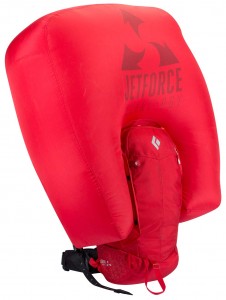
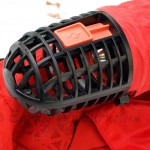
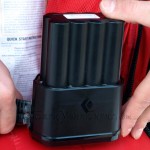
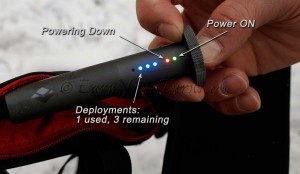
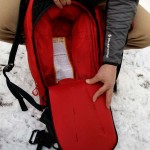
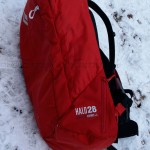
9 comments
1 ping
Skip to comment form
Good review Craig. Lots of good people working on these airbags from a variety of angles. I like the fact that this one blows up bigger. Still way pricey.
You haven’t comment about that so I assume that’s not the case. But is the air bag system removable and could it be set in different size packs? That’s the thing I like the most about Mammut packs, since for another ~$300 you can have a second pack that could work better for different occasions, not to say using the pack during summer months. It makes the pack much more versatile. Weird that BD decided not to use the classic T handle, how is this handle compared to a T handle when it comes to pulling it?
Craig- what about the packs ability to remain inflated under great stress? The tests above ground are impressive, but how does the airbag and fan retain pressure while there is a snow force pressing down (and from all angles) heavily on the airbag such as ending up 5 ft under when a slide stops or whiles moving.
If you’re 5 feet under snow and avy debris you’re already only a foot from being “6-feet under.” At that point I think you need more than an airbag that stays inflated to survive. Just sayin. 😉
It’s true but my question is geared more towards the bags ability to stay inflated under pressure… For dotsie let’s say 3 ft under.. You get the point 🙂
Same quandry. The purpose of the airbag is to keep you on top, not under. If you’re under, the bag didn’t do what you wanted/needed it to do and you’re just that much closer to 6-feet under.
As an aside, we all need to keep in mind if you pulled the trigger you didn’t use your head properly AND/OR you’re just unlucky.
Uggghh- dearest dotsie, you’re killin me here. One of the main purposes of “this” airbags added technology of a reverse cycle on the fan is to allow for a possible air pocket when buried….
The airbag is in no way a substitute for training and proper decision making to avoid avalanche terrain..nor a reason to in any situation to allow for increased risk tolerance.. So,, lets move on to the question at hand..
I doubt it can withstand tons of pressure without bursting or being compressed. The pressure the fan creates is certainly not measured in tons. Thus, in that case, I don’t think it matters much. If there’s that much pressure because you were buried in spite of the airbags promise to keep you on top, then you’ll probably have a hard time expanding your chest to breath the air from the airpocket that the airbag may or may not provide. More importantly, I’m not volunteering to “test” this feature in real avalanche conditions.
Airbags don’t promise to keep to you on top… They do increase your odds of being shuffled upward. Also, no ones asking ya to test it.. Let Craig answer and see if there’s any testing being done applying weight to the deployed airbag…
[…] Diamond has patents on an imminent system they are calling Jetforce. It will be officially introduced in October 2013 at the International Snow Science Workshop in […]